Notes from MASS Zoom Meeting on February 26, 2021
We had a good group with Keith, Silvio, Phil, Hank, Jim P., Dean and myself present. With our new start time of 7:30 PM, I was proud that we finished up at 9:30. I think monthly Zoom meetings are helping me keep the get-together to a 2 hour limit.
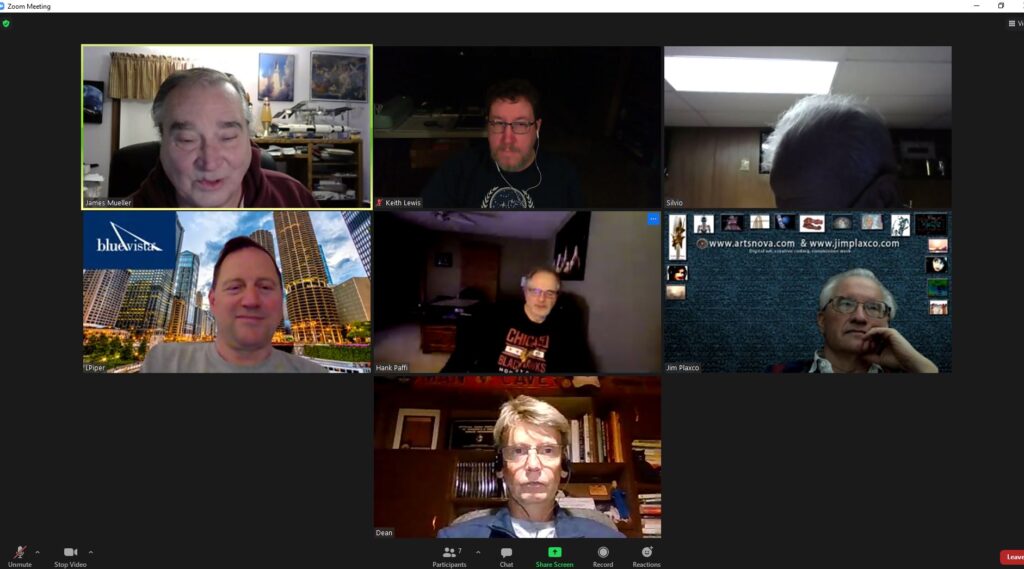
Our first order of business was to discuss the possibility of streaming our meeting to FaceBook so that the 220+ people in that forum could participate. No one voiced any opposition to trying it. We’ll have to see what tool we can use. Keith volunteered to research the matter. A product like Zoom webinar could accomplish the task but I’m not sure if I want to increase my zoom account from $15/month to $40/month. The core members would have the same zoom experience and be labeled as “Panelists” and the FaceBook people would be classified as “Attendees” with the ability to see our zoom screen and participate in Q&A, chat and “raise their hand”. I’d be happy to share our experience with a larger group as long as it doesn’t change our current give-and-take format. Keith might also research other tools that have a little less monetary impact.
I shared that I listened to a few online webinars including Joe DalSanto, COD’s astronomer, talking about “A New View of the Universe”. The talk discussed how scientists use gravitational waves to probe the cosmos. He started with Plato and Aristotle and ended with the current LIGO observatories and the proposed LISA constellation of satellites in space. Joe is a very polished speaker and his presentation was very informative. He also has a couple of astronomy courses on YouTube which I found very interesting.
The other 2 webinars were from the National Academy of Sciences, Engineering & Medicine. The first dealt with the Perseverance Rover landing on Mars and the second was titled “Space Nuclear Propulsion for Human Mars Missions. Chemical rockets peak with an efficiency of 450 seconds of specific impulse or Isp. Specific impulse is a measure of the efficiency of a rocket. It is a parameter in units of seconds and indicates how long 1 lb of fuel can impart a 1 lb force on the rocket. Nuclear thermal propulsion (NTP) is where a nuclear reactor heats hydrogen to 2700 degrees K (4400 F). NTP can double the Isp to 900 seconds and nuclear electric propulsion (NEP), which is less developed and more complex, can attain an Isp of >2000 seconds. NASA needs to research these technologies over the next decade, so they will be available for cargo and crew missions to Mars in the 2030s. I plan to read the 105 page report from the commission which is available online for free. Solar electric propulsion (SEP) will be used on the Lunar Gateway PPE module which will have 4 Hall ion thrusters that will take 50 kw of electricity from solar panels and turn it into a thrust with an Isp of 2600 seconds using xenon as fuel.
We then started our main topic, the landing of the Perseverance rover on Mars. It was an exciting time in the afternoon of February 18, 2021 when the landing occurred in Jezero Crater. The name Jezero comes from a small Bosnian town. If you want to be precise, the town is pronounce “Yezero” but its almost to late to unlearn my initial pronunciation. It is amazing that after traveling 300 million miles, the rover landed within a mile of its target.
The increased landing accuracy was enabled by an automated landing system that accurately timed the opening of the parachute based on identification of surface landmarks. Later in the landing sequence, when on rocket power, a hazard avoidance system took over and decided where to land. Because there were 100+ foot high cliffs, craters and sand dunes all within the landing ellipse, this site wasn’t chosen for previous landings. The 11 minute delay in getting signals from Mars meant that the landing had to be totally automated. Here is a geological map showing the different terrains that Percy might encounter.
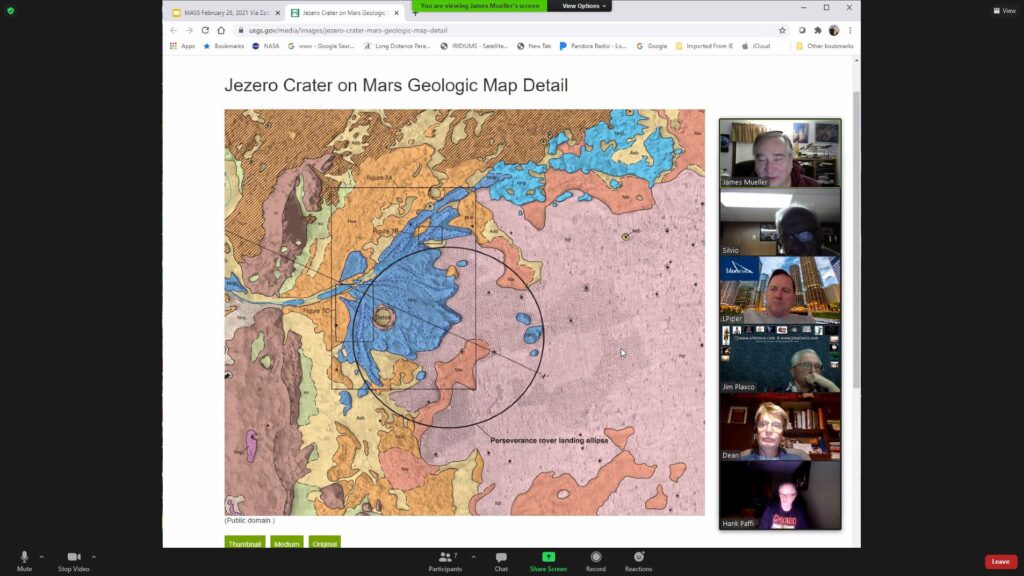
JPL has worked on the rover since its original sister rover, Curiosity, landed in Gale Crater on August 6, 2012. The development team of 1000s of people spent over 4000 person-years of effort to perfect it. Perseverance, or Percy, is 278 lb heavier than Curiosity and has 50% more science payload. Its total weight is 1025 kg or 2260 lb.
Percy performed a similar “7 minutes of terror” landing sequence. As it went from 12,000 mph to zero in 420 seconds, the rover experienced 11 G’s of deceleration. Probably more than a human could endure. It first used its heat shield to slow down in the atmosphere, ejected a parachute at super-sonic speeds, used the sky-crane thrusters to rocket close to the surface and finally repelled the last 25 feet on cables. After its wheels were placed on the surface, the cables were cut and the sky-crane rocketed off to crash far from the rover. The United States is now 2 for 2 in successful sky-crane landings.
Percy is scheduled to perform a 2 year nominal mission of searching for evidence of past life on Mars. It will use its fleet of science instruments to determine the best rocks to take in its 40 core samples for future return to Earth. Each core sample will be about the size of a piece of chalk. A rover on a future mission will pick up Percy’s core samples, put them in a solid fuel rocket that will then blast them into Mars orbit where another mission’s space probe will encapsulate the samples and send them back to Earth for study by scientific instruments too large to send to Mars. It sounds complicated and it is.
First day images were amazing. There is a picture from orbit while the rover was still on its parachute and another of the rover’s wheel next to an interesting porous rock. Scientists want to find a volcanic rock on Mars because they can use it to very accurately date it. There also is a picture of Percy dangling from the sky-crane. There are about 25 cameras on Percy, the sky-crane and the Ingenuity helicopter.
By Monday, February 22nd, we already had a movie showing Percy’s landing. Percy also has a microphone, so we also have the sound of a Martian breeze. We also learned that a message was encoded in the red and white segments of the parachute. In binary code the chute says, “Dare Might Things” and the coordinates for JPL in California.
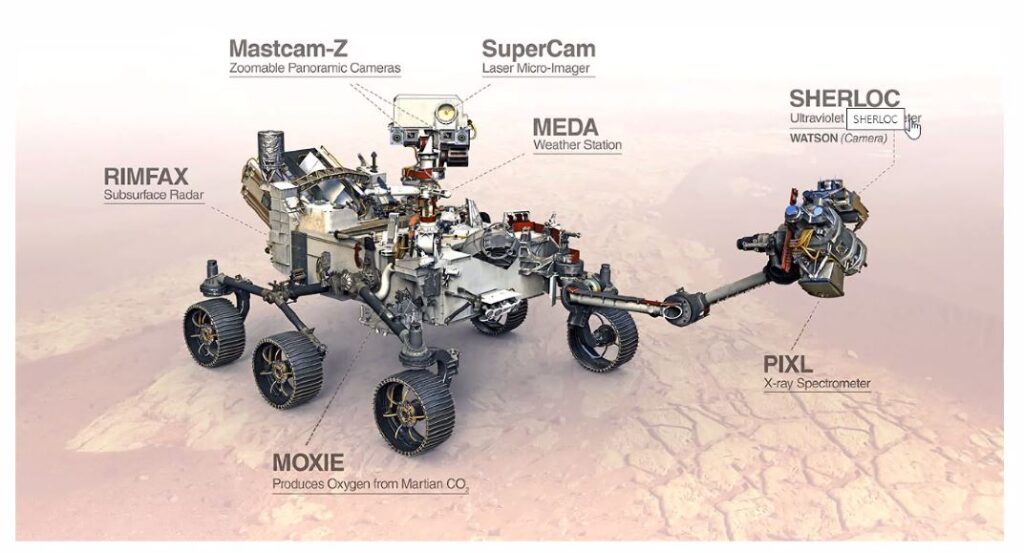
The instruments on Percy will enable some amazing science. They include: Sherloc, an ultraviolet spectrometer, with Watson, a closeup camera. Sherloc can do both Raman and luminescence spectrometry to search for organics. It also has a laser; PIXL, an x-ray spectrometer, can identify chemical elements at a tiny scale and also has a super close-up picture camera that can see stuff as small as a grain of salt; MEDA is the weather station with air temp, radiation & dust levels, relative humidity, a wind sensor and a pressure sensor. It has already recorded a nighttime temp on Mars of -80 C or -112 F; Mastcam Z contains zoomable panoramic cameras and can take 3D pictures and video. It could resolve a house fly from a soccer field’s distance; Super Cam, a laser micro imager, examines atomic and molecular makeup of rocks & soils with a camera, laser and spectrometers. It will seek the presence of organic compounds from targets as small as a pencil point from distance of 20 feet (7m); RimFax, a subsurface radar, can penetrate >30ft (10m) into the soil and rock and can detect ice, water and salty brines; MOXIE, a demonstration piece of equipment, will use electricity to extract oxygen from CO2 (carbon dioxide) atmosphere leaving CO (carbon monoxide) and gaseous oxygen. It will use 300 watts of power to produce 10g/hr or .022 lb/hr of oxygen. It is the first “in-situ” resource generation experiment flown to another world. A future model that could support human missions would need to be 100x larger. Human explorers will need 33-50 tons of fuel on the surface of Mars for their trip back to Earth. Liquid oxygen would be about ¾ of the mass of that propellant. The Mars atmosphere is only 1% the density of Earth’s and it is 96% CO2.
Jim Bell of Arizona State University, one of the chief designers of the Mastcam Z, provided a great tour of the first panorama picture from Mars. The tour is from the 21:30 mark to 28:30 in the YouTube video. It is amazing the amount of detail in the pictures when you zoom in. The “harbor seal” rock is something I hope the rover takes a closer look at. The panorama picture is 140 pictures that are stitched together and it takes 5000 uploaded commands for the rover to move for each picture and adjust focus. You can download the 650 mB picture from the NASA website for your own viewing pleasure.
Rover time on Mars is measured in “sols” which is a Mars day (24 hours and 37 minutes of a Earth day). The first drive of the rover will occur on Sol 8 (~Feb 27). The Ingenuity Helicopter with its 2 cameras is scheduled for first flight on Sol 60 (~mid April). The first flight should be to a height of 3 meters (10 ft) and hover for about 20 seconds. NASA will make sure the rover is about 100 meters away to avoid any collision. The copter has solar cells so it can recharge its battery between flights.
The other 2 Mars missions arrived in orbit earlier in February. The HOPE orbiter from the United Arab Emirates has already taken a great picture of Mars and intends to study the weather of Mars. Tianwen-1 from China is also in orbit. Amateur HAM radio operators have analyzed the signals from the spacecraft and detected that the orbit has been changed. China is very tight lipped and has said very little about what their plans are.
We then moved to our second topic, the upcoming solar cycle 25 of the Sun. One scientist predicts a “gang-buster” solar cycle 25 but consensus is small to average sunspot cycle. The Sun goes thru an 11 year alternating polarity magnetic cycle with the number of sunspots tracking with the cycle. Cycle 24 was about the same as its prediction, with a weak peak of 110 sunspots. Scott McIntosh, of the National Center for Atmospheric Research, thinks there are 4 main magnetic bands in the sun and they overlap in different ways adding and subtracting and then manifest themselves as the 11 year cycle. Sunspots can result in coronal mass ejections that can wreak havoc with satellites and the electrical grid on Earth. High sun activity can also warm the Earth’s atmosphere and caused satellite orbits to decay quicker. On March 12, 1989 a solar storm knocked out a large part of the electrical grid in Quebec and the Carrington Event, in early September 1859, fried telegraph wires and brought northern lights to the entire 48 states. In 2013, researchers estimated the US could lose trillions of dollars and slash its GDP by 15% if we were to be hit with another Carrington Event. NASA said cycle 24 was ending in December 2019 and cycle 25 had begun. During this lull between cycles, there were 206 days in 2020 that had no sunspots. But in a typical cycle at the peak, the sunspot average can be 140 to 220. Sunspot cycle 24 proved underwhelming with a peak average of 110. 12 other scientists agreed with the quiet cycle prediction for cycle 25. They predict the upcoming peak to be in July 2025, give or take 8 months. McIntosh estimates double that with a peak of 233. Cycle 23 was 50% stronger than 24 and in the 1950s, the peaks were even stronger. The NOAA space weather site has a complete historical list of the cycles and the consensus prediction for the upcoming Cycle 25. Looking at the graph, the peak in the 1950s was the highest in recent history, with 360 sunspots during October 1957. We are lucky that the Sun calmed down later in the 1960s so that the Apollo missions would not be impacted by the increased solar radiation. Cycles go back to 1750. With the highest historical peak around 1780 with a sunspot count of 400. Sky & Telescope had a recent article about predictions for Cycle 25. They say sunspots are part of an 11 year cycle observed since 1610. One 11 year cycle is with one magnetic polarity and the next is with the opposite polarity. This makes the true complete magnetic cycle of the sun 22 years long and it is called the Hale Cycle. Predicting the up and down of sunspots is difficult, most scientists predict a similar weak peak like cycle 24 peaking around July 2025 with 115 sunspots per month. Other scientists say the brevity of cycle 24 means cycle 25 will be strong one surpassing 180 sunspots per month. The prediction of a “gang-buster” cycle differs so much from the consensus, that we should know in just a few months which one will be true. I think I’ll make sunspot number reporting a regular MASS meeting item. A possible NASA mission called Solaris could provide never before seen views of the Sun’s poles and help provide information about the dynamics of the Sun. Here is the structure of the Sun according to NASA. Dean added that it is still unknown why the surface of the Sun (photosphere) is 10,000 degrees F but the atmosphere or corona is more than a million degrees.
Next was a couple of astronomy topics. First was the confirmation of the most distant solar system object. It has been nicknamed FarfarOut and was originally found by the Subaru Telescope in Hawaii in January 2018. Officially it is called 2018 AG37 and is 19.8 billion km from sun or 132 AU. It is 400 km (250 mi) in size and orbits in a ellipse that varies from 175 to 27 AU. The near part of the orbit is inside the orbit of Neptune. The new object could be eventually classified as dwarf planet. Previous distance record holder was nicknamed Farout and is 120 AU from sun.
Next was that the first black hole ever discovered, Cygnus X-1, is more massive that we thought. It’s a stellar black hole in orbit around a star in the constellation Cygnus. It was first identified in 1964. The black hole’s partner is a blue supergiant star. Early investigation estimated it to be 6070 light-years (ly) away but now it is believed to be 7240 ly. Because of the increased distance, the star is larger than first thought. Astronomers used the VLBA radio telescope and the parallax method to determine the star’s distance. The blue giant is now estimated to be 40.6 times the mass of the sun and the black hole’s mass has increased from 14 times to 21 times the mass of the sun. The dilemma for astronomers is that stars should only be able to collapse into a black hole no larger than 15 times the mass of the sun. The 21 times the mass of the sun has them baffled.
Conversation then turned to SpaceX topics. SpaceX is beginning to build a new version of its StarLink satellites. The FCC in November 2018 approved SpaceX to launch 11,943 satellites. For an initial deployment SpaceX wants to launch 4425 satellites by 2024. The first version was v0.9 and 60 of them were on the first StarLink 0 launch. Those prototype satellites have almost all been deorbited. The StarLink 1 thru StarLink 8 launches put 478 version 1.0 satellites into orbit. Starlink 9 through Starlink 16 had a new version, v1.5, of satellites which had a sun shade that made them too dim for human eyes to see when they were in their final orbit. Beginning with the Transporter 1 launch, 10 newer v2.0 satellites with laser communication capability were launched. So far, there are 1023 production satellites in orbit from 19 dedicated StarLink launches. The new inter-satellite laser communication will reduce the need for ground stations as well as decrease latency and increase transmission speed. The Beta program for using StarLink started in October 2020 and costs $99/month and has a startup fee of $499 for the StarLink Kit that includes a user terminal and wi-fi router. Initial speeds are hitting 100 Mbps. SpaceX has a filing with the FCC that said download speeds of up to 10 Gbps are coming. SpaceX has begun a pre-order program for StarLink service for a refundable $99. Service is not guaranteed and is only available in the northern US, Canada and UK. Musk has said StarLink speed will double to 300 Mbps sometime in 2021. Starlink has over 10,000 users now since the Beta started 3 months ago. When cash flow is positive, SpaceX will take StarLink public, Musk said every new satellite constellation in history has gone bankrupt, we hope to be the first that does not. In 2019, Musk said StarLink could bring in revenue of $30 billion/year or 10 times its rocket business income.
SpaceX next crewed mission will launch April 20, 2021. The CREW2 mission includes Megan McArthur (pilot), Shane Kimbrough (commander), ESA astronaut Thomas Pesquet and JAXA astronaut Akihiko Hoshide. The CREW1 crew will return from the ISS in late April or early May. Boeing’s uncrewed Starliner test is scheduled for March 25 and will spend a week docked to ISS. The Russian Soyuz MS-18 (64S) is scheduled to launch April 10 bringing 3 Russian cosmonauts to the ISS. The MS-17 Soyuz capsule is to return a week later with 2 cosmonauts and Kate Rubins. A Cygnus cargo mission just launched to the ISS on February 20 carried a Commercial Cargo record of 8400 lbs of supplies and scientific experiments.
An all new civilian Dragon mission was announced. Billionaire Jared Isaacman has chartered a crew Dragon capsule dubbed Inspiration4 for later in 2021. The crew of 4 includes him, a person who wins a raffle, a St. Jude ambassador and a “shark tank” style contest winner. The capsule will not dock with the ISS and will orbit for up to 4 days. Isaacman has committed to donate $100 million to St Jude Hospital and raise another $200 million thru the contests for the 2 seats. This mission differs from the Axiom Space mission that will have its Dragon capsule dock with ISS in 2022. The St. Jude ambassador was later named to be Hayley Arceneaux, a 29 year old cancer survivor. She will become the youngest American to ever fly in space. She is a physician assistant at St. Jude and will join Jared Isaacman ( a 38 years old billionaire) in the first all civilian SpaceX mission, a 2-4 day flight in October 2021. Hayley is the first person with a prosthetic body part to fly in space. She lost part of her leg from her bout with bone cancer. The Inspiration4 flight will also include winners of a sweepstakes contest of contributors to St. Jude Hospital and a “shark tank” type contest. Winners will be announced in March.
Development of the new rocket, StarShip, by SpaceX has had another RUD (rapid unscheduled disassembly). The SN9 prototype on its 10 km high flight test landed at an angle and velocity even worse than the SN8 explosion. 1 of the 2 Raptor engines needed for landing did not ignite. Musk said they will try to re-light all 3 Raptor’s next time and then throttle down to just 2 for the landing. SN10 can be seen on its launch pad waiting its turn which could come as early as March 3. SpaceX is halfway done building the first prototype of the first stage booster rocket, BN1. It will be 18 rings of stainless steel tall and is called Super Heavy. The 16.5 million lb thrust from the 28 Raptor engines of the Super Heavy will be equivalent to 10 Falcon 9’s. The height will be 70 meters or 230 ft. The engine configuration will be 20 engines in an outer ring and 8 in the center.
The last SpaceX news item was the loss of the first stage booster on the 19th StarLink launch. They had 24 successful landings up to this attempted landing. It was the 6th launch for this core. SpaceX has had a total of 74 successful landings, 22 on land & 52 on barges. Later it was said that the failure was due to “heat damage” but no specifics were given. Others first stage cores have done 8 launches and landings without incident. SpaceX hopes to get to at least 10 launches and landings before having to do major refurbishment on the rocket. On this launch, only half of the fairing was successfully recovered. The other was damaged. SpaceX seems to have stopped trying to catch the fairings in the large net boats. They seem to be content with just pulling the fairings out of the water. There have been 107 successful Falcon 9 launches. Nineteen have been dedicated to StarLink satellites. There are 1083 production satellites launched, only 15 deorbited, leaving 1068 production satellites on orbit.
In NASA news, the second “Green Run” test firing of the first SLS booster had been scheduled for late February. But a problem with an oxygen valve on one of the 4 RS-25 engines had a problem. Boeing has to set up some scaffolding and obtain some special tools to perform the fix on the valve. Sometimes Boeing and SLS really seem to have a cloud hanging over them. The new re-test will be considered successful if it goes only 4 of the full 8 minutes of engine firing. This delay will cause the Artemis 1 launch to now slip into 2022. The original test on January 16 only ran for 67 seconds not the full 8 minutes because of a shut-down caused by an anomaly in one of the four engines during a gimble test. It took a month to prep the core stage after the test. OMB has estimated that SLS will cost $2 billion per launch. On the positive side, 15 of the 23 objectives were accomplished on the first “green run” test firing. Four objectives got most of the data needed, 3 had partial data and 1 had none. The last one needed data on how the liquid oxygen tank pressure would respond when the oxygen was used up and the tank emptied. That didn’t happen in the abbreviated test.
Testing has begun on the new RS-25 engines for SLS rockets. New hardware will significantly reduce the cost of the engines. Aerojet Rocketdyne is under contract to build 24 new engines. The new configuration will result in a 30% cost reduction of the engine that flew on the Space Shuttle. But from what I had read, the recent contract for 18 more engines is costing $146 million per engine. With SLS using 4 of them per rocket, that is almost $600 million just for the engines. An expendable Falcon Heavy launch costs about $150 million. I don’t see the economics making much sense. With the 16 RS-25s left over from the Space Shuttle, NASA will have a total of 40 engines, enough for 10 SLS rockets.
NASA has delayed the down-selection of the 3 competing Human Landing Systems (HLS) by 2 months. A combined $967 million in seed money was awarded in 2020 for 3 potential designs. The original timeline to down-select by late February 2021. Congress only gave NASA $850 million of the requested $3.2 billion last December. In the original seed money, SpaceX got $135 million for its lunar StarShip, Jeff Bezos’ Blue Origin National Team got $579 million ( the team includes Lockheed Martin, Northrop Grumman and Draper), and Dynetics got $253 million for its lander which it is partnering with Sierra Nevada.
Jen Psaki Biden’s Press Secretary says the new administration will continue with the Artemis program. But there were no details on the timeline. Vice President Pence was the one who committed NASA to the 2024 first Artemis manned landing on the moon timeline. The HLS is being underfunded by Congress and is probably the issue that will make 2024 impossible. I’m all for a more reasonable and hopefully less costly plan that gets us there by 2028. That was NASA’s original timeline. The Europeans have committed almost $1 billion to build 3 more service modules for the Orion capsule. Bringing their contribution to 6 service modules for manned Orion missions.
The acting NASA chief weighed in on NASA priorities. Steve Jurczyk says they will continue to support Artemis but the biggest factor in timeline is money, Congress only gave $850 million of the requested >$3 billion requested for HLS (down-select delayed couple of months to April) and NASA will have to revisit the 2024 deadline. Artemis 3 would be the first manned landing mission on the moon. Artemis 2 lifts off in 2023 (a manned mission that loops around moon). The Artemis 1 launch date of November 2021 is in jeopardy because the “Green Run” test firing has to be redone before the rocket can be shipped to Florida. During the test, NASA needs the rocket to reach equilibrium from a pressure and thermal standpoint to confirm that modeling is accurate. The rest of Artemis 1 rocket is at Kennedy and waiting for the core stage to begin integration. Commercial Crew is important for ISS. Boeing is to repeat the uncrewed test flight of the StarLiner capsule on March 25. It looks like Boeing implemented the corrective action plans in its software. SpaceX will launch its third crewed flight, CREW2, in April. Russia says they need 3 successful crew flights to agree to a “ride share” plan, We could see a cosmonaut on CREW3 later in 2021. The Perseverance Mars rover is big science milestone. Climate change will also be a priority. There will be a new position of senior climate advisor in the cabinet to coordinate climate-related activities in the agency. Also JWST will launch October 31 and is still on track. Lucy, a mission to Jupiter Trojan asteroids, is another October launch and is on schedule but DART, a mission to impact an asteroid, is scheduled for July but may need to change to back-up slot. Europa Clipper which is scheduled for 2024 is now not formally committed to SLS. If the mismatch between the two systems, SLS and Clipper isn’t easily solvable, it could be moved to a commercial rocket like Falcon Heavy. NASA must decide by end of 2021. The first two missions of CLPS (Commercial Lunar Payload Services) are scheduled to occur in the Summer of 2021. Astrobotic might make that date but Intuitive Machines might delay its mission to 2022.
There were rumors that the ex-Democratic Senator, Bill Nelson, of Florida was in the running as the next NASA Administrator. Nelson was always a big proponent of NASA and even flew on the Space Shuttle. But people remember that he was negative on the nomination of Jim Bridenstine because Jim was a politician. Nelson, even though retired, really was a career politician. Time will tell. I’d like to see an administrator who doesn’t have Texas, Alabama or Florida roots, just to make decisions less in-bred.
Watchdog says Artemis is going to cost a lot. The Office of Inspector General says the program will cost $86 billion thru the end of 2024 (FY 2012 thru FY 2025). $35 billion has already spent over the last 8 years but $50 billion will be needed over the next 5 years. The spending amounts in billions are spread over these parts of Artemis: Orion ($11.2 spent + $6.4 more needed), SLS ($16.4 spent + $10.9 more needed), ground systems ($4 spent + $2.2), Gateway ($.5 spent + $2.8), HLS ($.4 spent + $21.3), other R&D ($2.7 spent + $6.9). For comparison NASA spent $288 billion on Apollo and related efforts between 1960 and 1973 in today’s dollars. The biggest surprise is the $21.3 billion needed to develop the lunar human landing system (HLS).
NASA picks SpaceX to launch the first 2 pieces of the Lunar Gateway. The PPE (Power & Propulsion Element) & HALO (Habitation & Logistics Outpost) would launch on a Falcon Heavy in May 2024. The original plan was to launch them separately on smaller rockets and then dock them in orbit. But that was considered more risky and expensive. SpaceX is getting $332 million for the launch (3x the $117 million that NASA is paying for the Psyche mission in 2022). The increase cost is being justified because SpaceX has to develop a bigger fairing and ground support equipment to support the payload. SpaceX is charging the Air Force $316 million for a large satellite launch that needs a new mobile service tower.
NASA decides to launch Europa Clipper on a commercial rocket in 2024. Some structural loads caused by SLS (possibly shaking from the solid rocket boosters on the spacecraft) raised manger’s concerns and a SLS rocket might not be available until 2025 due to use on Artemis. That would make them miss the launch window which is only Oct 10 to 30 in 2024. SLS was to cost $1.5 billion more than a commercial rocket even with the extension of the mission from 3 to 6 years in order to make gravity flybys of Mars on Feb 28, 2025 and Earth on Dec 2, 2026. The less powerful commercial rocket will need the gravity assists to get to Jupiter on April 11, 2030. Europa Clipper is a top-of-the-line NASA flagship class mission with a cost of $4.25 billion. Any commercial rocket will need 3 successful flights before it will be considered for the October 2024 launch. Europa Clipper is expected to weigh over 13,000 lbs with a full fuel load. An expendable Falcon Heavy is only rocket expected to be available in 2024. Clipper will make 45 close flybys of Europa, passing as close as 16 miles above the surface of Jupiter’s moon. It will survey the entire moon with its 9 scientific instruments. It also has a ground penetrating radar to determine thickness of the ice sheets and look for location where water could be erupting.
NASA wants to set new radiation limits for astronauts. The limit now is 120-400 millisieverts (mSv) for a life time dose based on age and gender (a 55 year old male is allowed 400 mSv, a 35 year old female only 120 mSv). The new limit will be 600 mSv for everyone. Canada, Europe and Russia all have a 1000 mSv limit. On Earth we are exposed to 3-4 mSv/year. On the ISS astronauts typically get about 300 mSv/year. Cancer is primary concern of the radiation but changes to heart muscle like making it more tough and fibrous. A condition that could lead to heart failure. Other effects include atherosclerosis in blood vessels, general inflammation, cell death and DNA damage. A 3 year round trip to Mars might expose an astronauts to more than 1000 mSv.
Who will get us to the moon first? The SLS or StarShip. I posed that question to the group but can’t remember their response. For me, I think StarShip might win the race. We will know much better by the end of 2021. By then I think SpaceX will have placed a prototype StarShip into Earth orbit. The Super Heavy booster along with Starship upper stage both use methane and liquid oxygen to power their Raptor engines. Super Heavy gets 15 million pounds of thrust from its 28 engines which is twice as much as the Saturn V and will put 100+ mt into LEO. The Starship has 6 engines, 3 optimized for atmosphere operation and 3 for vacuum operation. It can hold a crew of up to 100 persons. The cargo version can be equipped with extra fuel tanks for orbital refueling or its cargo bay can be full of satellites. The entire rocket is reusable and can make a soft landing on Earth, the Moon or Mars. It is maturing rapidly. SN8 & SN9 have crashed. We’ll see how SN10 does in a few days. SLS has 4 RS-25 engines that run on hydrogen and liquid oxygen plus 2 solid rocket booster that total to 8.2 million pounds of thrust, 5% more than the Saturn V. Its upper stage has 1 RL-10 engine already in use on Atlas and Delta rockets. The Orion capsule can support a crew of up to 6 for 21 days. A later, more advanced second stage, will increase the lift capability to 120 mt to LEO. The linked website above shows a graphic of numerous rockets and their launch cost and lift capability: Saturn V $1.3 billion/140 mt, Space Shuttle $1.65 billion/27 mt, Atlas V $120 million/20 mt, Ariane 5 $223 million/20 mt, Falcon 9 $62 million/13 mt, Falcon Heavy $150 million/63 mt, SLS Block 1 ~$2 billion/95 mt, Starship unknown/100 mt. StarShip cost is listed as unknown but Elon Musk is on record saying that because it is totally reusable, the only cost for a launch is fuel and that amounts to about $2 million. Artemis 2, the first crewed mission, will do a flyby of moon in August 2023. There is no specific date for StarShip but the DearMoon mission that SpaceX sold to a Japanese investor is planned for 2023. It all comes down to NASA, who has years of testing and experience, but is subjected to fluctuating taxpayer budgets and policy changes versus a relatively new company, SpaceX, who has launched 109 Falcon 9 rockets with a 98% success rate and has a dedicated long-term cash flow. We live in exciting times.
Lastly, a recent poll says that the American public wants space dominance but investing in space research ranked 25 out of 26 items for Biden. The website has an informative bar chart showing the results of many questions. 1 in 3 adults said sending human astronauts to the moon or Mars should be a priority. The poll was conducted during February 12-15 of this year among 2200 US adults. Most of the MASS members thought that was a pretty small group, making the results a little suspect. The 1 in 3 for sending people to the moon or Mars seems high until you see that it is 30 percentage points lower than monitoring key parts of the Earth’s climate system (63%) or monitoring asteroids that could strike earth (62%). 47% say it’s essential that the US continue as world leader in space exploration. Few think it should be a high priority for the Biden administration. 84% said control COVID-19 in the US and 81% stimulate the economy from the pandemic. 52% said China is a major threat to the US in space compared to 45% who were concerned about Russia.
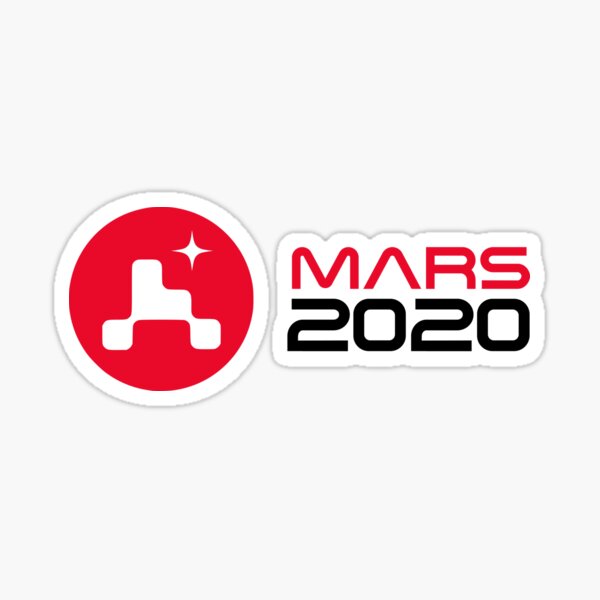
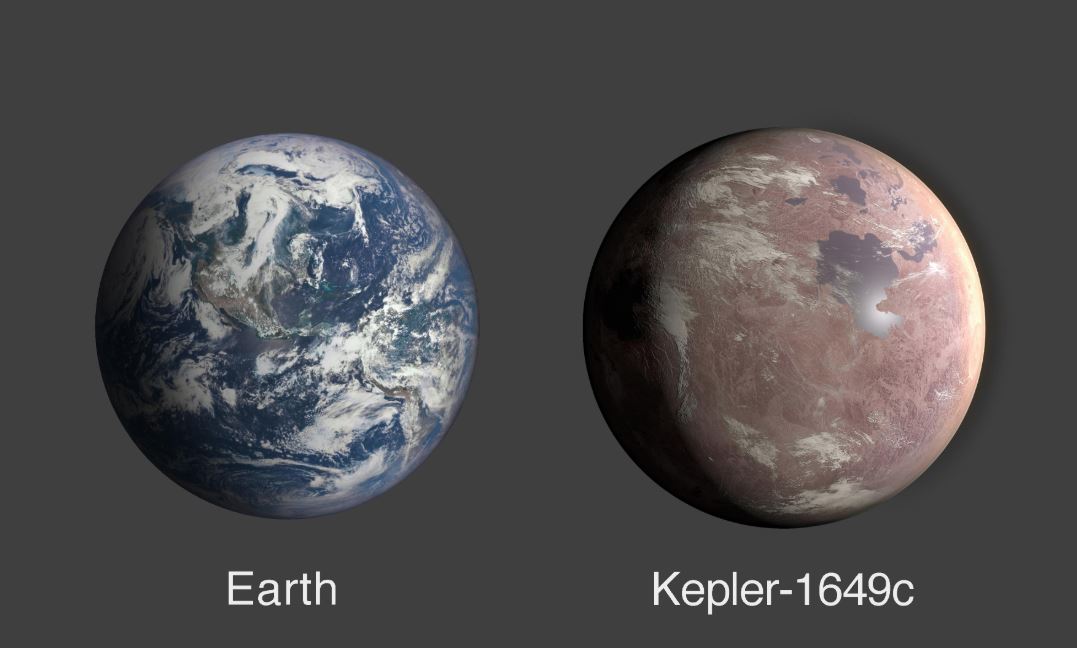
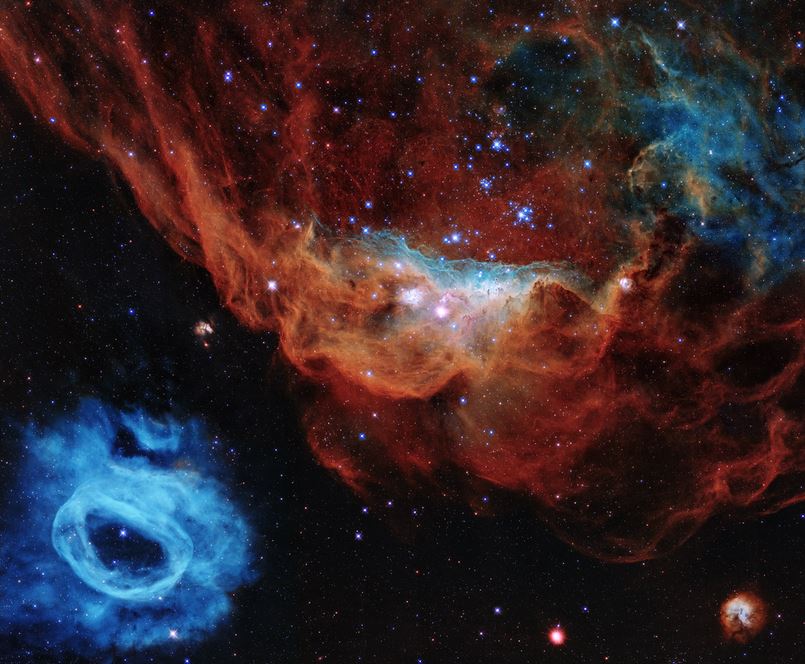
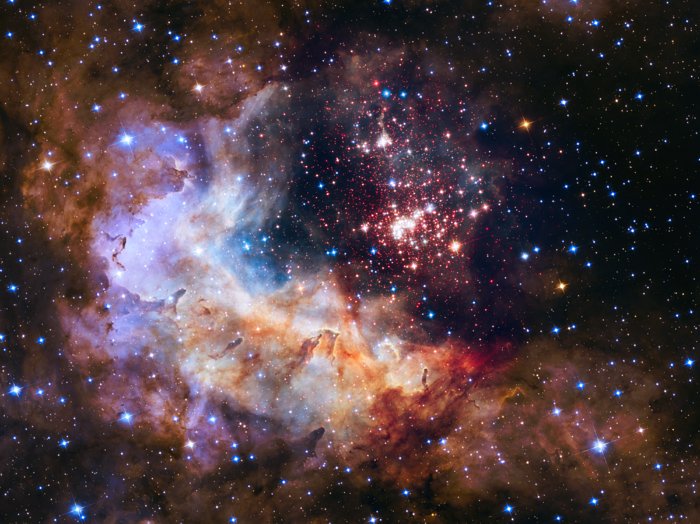
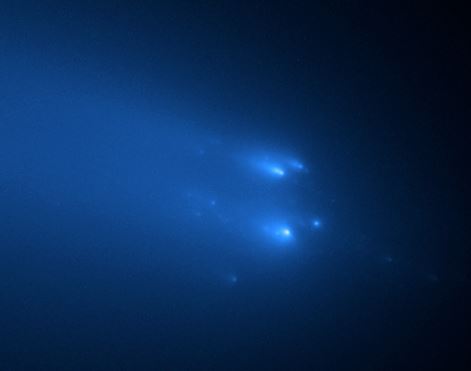

Recent Comments